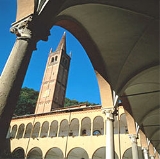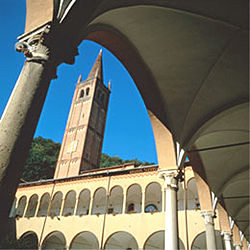
Abano Terme
Encyclopedia

Comune
In Italy, the comune is the basic administrative division, and may be properly approximated in casual speech by the English word township or municipality.-Importance and function:...
in the province of Padua
Province of Padua
The Province of Padua is a province in the Veneto region of Italy. Its capital is the city of Padua.-History and territory:...
, in the Veneto
Veneto
Veneto is one of the 20 regions of Italy. Its population is about 5 million, ranking 5th in Italy.Veneto had been for more than a millennium an independent state, the Republic of Venice, until it was eventually annexed by Italy in 1866 after brief Austrian and French rule...
region, Italy
Italy
Italy , officially the Italian Republic languages]] under the European Charter for Regional or Minority Languages. In each of these, Italy's official name is as follows:;;;;;;;;), is a unitary parliamentary republic in South-Central Europe. To the north it borders France, Switzerland, Austria and...
, on the eastern slope of the Colli Euganei
Colli Euganei
Colli Euganei are located in the Veneto region of northern Italy, a few kilometers south of Padua. They take their name from the Euganei, a semi-mythical population who inhabited the area before the Veneti....
; it is 10 kilometers southwest by rail from Padua
Padua
Padua is a city and comune in the Veneto, northern Italy. It is the capital of the province of Padua and the economic and communications hub of the area. Padua's population is 212,500 . The city is sometimes included, with Venice and Treviso, in the Padua-Treviso-Venice Metropolitan Area, having...
. Abano Terme's population is 19,062 (2001) (in 1901 it was only 4,556).
The town's hot springs and mud baths are the main economic resource. The waters have a temperature of some 80°C.
History
The baths were known to the Romans as Aponi fons or Aquae Patavinae. A description of them is given in a letter of TheodoricTheodoric the Great
Theodoric the Great was king of the Ostrogoths , ruler of Italy , regent of the Visigoths , and a viceroy of the Eastern Roman Empire...
, the king of the Ostrogoths. Some remains of the ancient baths have been discovered (S. Mandruzzato, Trattato dei Bagni d'Abano, Padua, 1789). An oracle of Geryon
Geryon
In Greek mythology, Geryon , son of Chrysaor and Callirrhoe and grandson of Medusa, was a fearsome giant who dwelt on the island Erytheia of the mythic Hesperides in the far west of the Mediterranean. A more literal-minded later generation of Greeks associated the region with Tartessos in southern...
lay near, and the so-called sortes Praenestinae (C.I.L. i., Berlin, 1863; 1438-1454), small bronze cylinders inscribed, and used as oracles, were perhaps found here in the 16th century.
The baths were destroyed by the Lombards in the 6th century, but they were rebuilt and enlarged when Abano became an autonomous comune
Medieval commune
Medieval communes in the European Middle Ages had sworn allegiances of mutual defense among the citizens of a town or city. They took many forms, and varied widely in organization and makeup. Communes are first recorded in the late 11th and early 12th centuries, thereafter becoming a widespread...
in the 12th century and, again, in the late 14th century. The city was under the Republic of Venice
Republic of Venice
The Republic of Venice or Venetian Republic was a state originating from the city of Venice in Northeastern Italy. It existed for over a millennium, from the late 7th century until 1797. It was formally known as the Most Serene Republic of Venice and is often referred to as La Serenissima, in...
from 1405 to 1797.
Main sights
- Abano Cathedral, or the cathedral (duomoDuomoDuomo is a term for a cathedral church. The formal word for a church that is presently a cathedral is cattedrale; a Duomo may be either a present or a former cathedral . Some, like the Duomo of Monza, have never been cathedrals, although old and important...
) of St. Lawrence. The current edifice was erected in 1780 over a pre-existing church which was allegedly destroyed by Cangrande della Scala. The bell tower has parts from the 9th/10th and 14th centuries. - The Montirone Gallery, housing works of Il Moretto, Palma the Younger, Guido ReniGuido ReniGuido Reni was an Italian painter of high-Baroque style.-Biography:Born in Bologna into a family of musicians, Guido Reni was the son of Daniele Reni and Ginevra de’ Pozzi. As a child of nine, he was apprenticed under the Bolognese studio of Denis Calvaert. Soon after, he was joined in that...
, Giandomenico Tiepolo and others. - The Sanctuary of the Madonna della Salute or of Monteortone (built from 1428). It lies on the site where the Madonna appeared to Pietro Falco, healing his wounds. The church is on the Latin cross plan, with a nave and two aisles with three apses decorated by a frieze. It has with a Baroque portal (1667), a noteworthy bell tower, presbytery frescoes portraying the Histories of St. Peter and Virgin by Jacopo da Montagnana (1495) and Palma the Younger's altarpiece depicting Christ Crucifixed Between St. Augustine and St. Jerome.
Just outside the city is San Daniele Abbey (11th century). 6 km from the city is also Praglia Abbey, founded in the 11th century by Benedictine monks and rebuilt in 1496-1550. The church of the Assumption, with a marble portal from 1548, has a Renaissance style interior. Noteworthy is the four cloister complex.
External links
}}}

